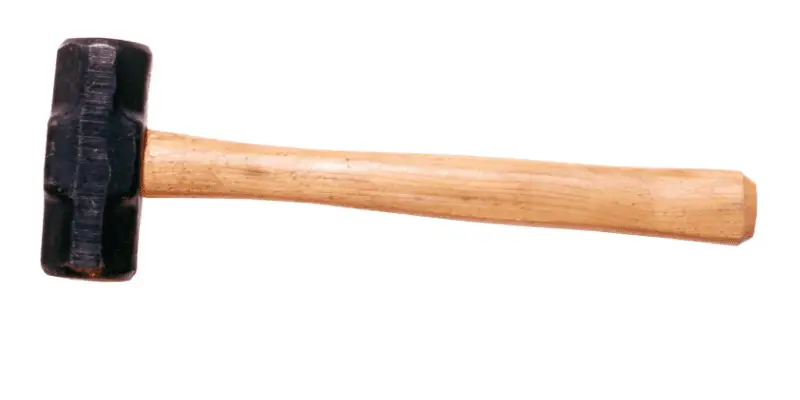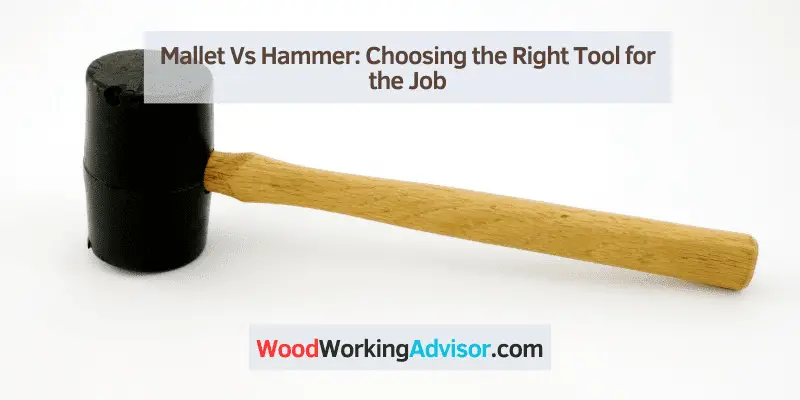A mallet is a tool with a large head used for driving objects, typically made of wood or rubber, while a hammer has a smaller head and is used for striking or driving nails. Both tools are used for different tasks and have distinct features, making them suitable for specific purposes.
Understanding the differences between a mallet and a hammer can help you choose the right tool for your project. We will explore the unique characteristics of mallets and hammers, their uses in various applications, and considerations for selecting the right tool for your needs.
By the end, you will have a clear understanding of when to use a mallet or a hammer and make informed decisions for your woodworking, construction, or DIY projects.
Understanding The Difference
Understanding the difference between mallets and hammers is crucial for anyone who regularly works with tools. Both mallets and hammers are basic hand tools used in a wide variety of applications. While they may appear somewhat similar at first glance, there are significant differences in their design and intended usage. Let’s delve into the definitions of mallets and hammers and explore their unique features to gain a clearer understanding of these essential tools.
Definition Of Mallet
A mallet is a tool with a large, usually wooden, head used for driving a chisel or for striking a surface without causing damage. The head is typically made of a non-metallic material such as rubber, plastic, or wood, which helps to minimize surface damage during striking. Mallets are often used in woodworking and metalworking to deliver controlled blows without leaving behind marks or dents.
Definition Of Hammer
A hammer, on the other hand, is a heavy- or lightweight tool with a metal head and a handle, used for breaking things or driving in nails, among other applications. The metal head of a hammer is designed to provide forceful impact, making it suitable for tasks that require more power, such as driving nails, breaking objects, or shaping metal.
Unique Features Of Each Tool
Mallet
- Made from non-metallic materials like wood, rubber, or plastic
- Designed for controlled and precise strikes
- Minimizes surface damage
- Commonly used in woodworking and metalworking
Hammer
- Features a metal head for forceful impact
- Used for tasks requiring greater power, such as driving in nails and breaking objects
- Available in heavy- and lightweight options for various applications
- Commonly used in construction, carpentry, and metalworking
Applications And Use Cases
When it comes to mallets and hammers, understanding their applications and use cases is crucial for choosing the right tool for the job. Each of these tools has specific purposes and is best suited for different tasks. Let’s explore the various applications and use cases for mallets and hammers in woodworking projects, metalworking projects, and construction and DIY tasks.
Woodworking Projects
Woodworking projects require precision and care, making the choice between a mallet and a hammer essential. Mallets are commonly used in woodworking for delicate tasks such as chiseling, carving, and assembling joints. The soft striking surface of a mallet ensures that the workpiece is not damaged during these intricate operations. Additionally, the wooden or rubber head of a mallet reduces the risk of leaving indentations or marks on the wood, making it ideal for fine woodworking projects.
Metalworking Projects
In metalworking projects, the force and durability of hammers are often indispensable. Hammers are utilized for shaping, bending, and forging metal. The sturdy and heavyweight construction of a hammer enables it to withstand the rigors of metalworking, allowing for efficient manipulation of metal materials. Hammers come in a variety of shapes and sizes, each designed for specific metalworking tasks, providing versatility and precision when working with metals.
Construction And Diy Tasks
When it comes to construction and DIY tasks, both mallets and hammers have their distinct roles. Mallets are commonly used for tasks such as assembling furniture, driving chisels, or tapping things into place without causing damage. On the other hand, hammers are essential for tasks like driving nails, removing old fasteners, and demolition work. The versatility of hammers makes them a go-to tool for various construction and DIY tasks, offering the necessary strength and force required for completing these projects efficiently.

Considerations For Choosing The Right Tool
When choosing between a mallet and a hammer, it’s essential to consider the type of material you’ll be working with. If precision and delicate materials are involved, a mallet may be preferable. However, for heavier-duty tasks and more forceful impact, a hammer might be the better choice.
Both tools serve different purposes and understanding the specific requirements of your project is crucial in making the right decision.
Material Of The Workpiece
When deciding between a mallet and a hammer, one crucial consideration is the material of the workpiece. Harder materials, such as metal or stone, may require the use of a hammer due to its ability to deliver greater impact force. Conversely, for softer materials like wood or plastic, a mallet would be more suitable as it provides the necessary force without damaging the workpiece.
Desired Impact Force
Another vital factor to consider is the desired impact force. If a high impact force is needed to drive in nails, chisels, or stakes, a hammer would be the preferred choice. In contrast, if a softer, more controlled impact is required for tasks like woodworking, a mallet’s rounded striking head would be more appropriate.
Precision And Control Requirements
Consider the precision and control requirements of the task at hand. Mallets, with their larger and softer striking surface, offer better control and are less likely to leave marks or dents. On the other hand, hammers provide more precision due to their smaller and narrower striking area, making them suitable for tasks that demand accuracy.
Ergonomics And Safety
When it comes to tools like mallets and hammers, considering the ergonomics and safety aspects is crucial. These factors play a significant role in not only optimizing efficiency but also in preventing potential injuries and strains. Let’s delve into the ergonomic and safety features of mallets and hammers.
Handle Design And Grip
The design and grip of a tool’s handle are essential for ensuring ergonomic efficiency and safety. A well-designed handle with a comfortable grip reduces the risk of hand fatigue and strain, enabling the user to maintain control and precision during tasks. The handle’s shape, material, and texture all contribute to the overall comfort and safety of the user.
Impact On Wrist And Arm
When using mallets and hammers, the impact on the wrist and arm should be carefully considered from an ergonomic and safety perspective. The repetitive motion of striking can lead to strain on the wrist and arm if not properly handled. Selecting a tool that minimizes these impacts through thoughtful design and weight distribution is paramount for reducing the risk of long-term musculoskeletal issues.
Protective Gear Recommendations
While using mallets and hammers, it is essential to prioritize safety by utilizing appropriate protective gear. Wearing sturdy gloves can provide a layer of protection for the hands and enhance grip, reducing the risk of slippage and related injuries. In addition, eye protection such as safety goggles should be worn to shield the eyes from any potential flying debris or particles during striking tasks.
Maintenance And Longevity
When it comes to selecting the right tool for your woodworking or metalworking projects, it’s crucial to consider the maintenance and longevity of the equipment. This is especially true when comparing the durability and care requirements of mallets versus hammers. Let’s delve into the key differences in terms of durability, care, and potential for wear and tear for each tool.
Durability Of Mallets Vs Hammers
Mallets are typically made from rubber, wood, or plastic materials, offering a high level of durability. The construction of mallets ensures that they resist damage and maintain their structural integrity even after prolonged use. They are designed to be impact-resistant, making them a reliable tool for various tasks without the risk of chipping or splintering.
On the other hand, hammers, being metal-based tools, are also durable but are more susceptible to chips, dents, and corrosion. The striking surface of a hammer is especially prone to wear and may require regular maintenance to prevent deterioration over time.
Care And Upkeep Of Each Tool
Mallets do not require extensive maintenance and can be simply wiped down with a damp cloth to remove any debris. Wooden mallets may benefit from occasional conditioning with wood oil to preserve their natural finish and prevent drying out.
Hammers, however, need more attentive care, especially for the striking surface. Regular inspection for signs of wear, such as mushrooming or chipping, is essential. Additionally, keeping the hammer head clean and applying a thin coat of oil can prevent rust formation, ensuring the longevity of the tool.
Potential For Wear And Tear And Replacement Needs
- Mallets are generally less prone to wear and tear due to their durable construction, resulting in a longer lifespan.
- In the event of damage, such as a cracked handle or deformed head, replacement mallets are readily available, providing a straightforward solution to prolong the tool’s use.
- Due to the nature of their metal components and the constant impact during use, hammers may experience wear on the striking surface and require periodic replacement or refurbishment.
- Maintaining hammers and promptly addressing signs of wear can extend their service life to minimize the frequency of replacements.
Frequently Asked Questions For Mallet Vs Hammer
What Are The Main Differences Between A Mallet And A Hammer?
A mallet is typically made of rubber or wood and is used for delicate work, while a hammer is made of metal and used for heavier tasks. The mallet is best for tasks that require a softer touch, while a hammer is designed for more forceful impact.
When Should I Use A Mallet Instead Of A Hammer?
You should use a mallet when you need to avoid damaging delicate surfaces or materials, such as when working with wood carving or assembling furniture. The mallet’s softer material distributes force more gently, making it ideal for tasks that require precision and care.
Can A Hammer Be Used In Place Of A Mallet?
While a hammer can technically be used in place of a mallet, the harder material and design of the hammer make it less suitable for delicate tasks. The force generated by a hammer could potentially damage the surface or materials being worked on, so it’s generally best to use the correct tool for the job.
Conclusion
After comparing mallets and hammers, it’s clear that each has its unique uses. For heavy-duty striking, the hammer’s solid head is ideal, while the mallet’s softer head is perfect for delicate work. Both tools are essential in a well-equipped toolkit, providing versatility and efficiency for a wide range of projects.
Choose the right tool for the job and work with confidence.


